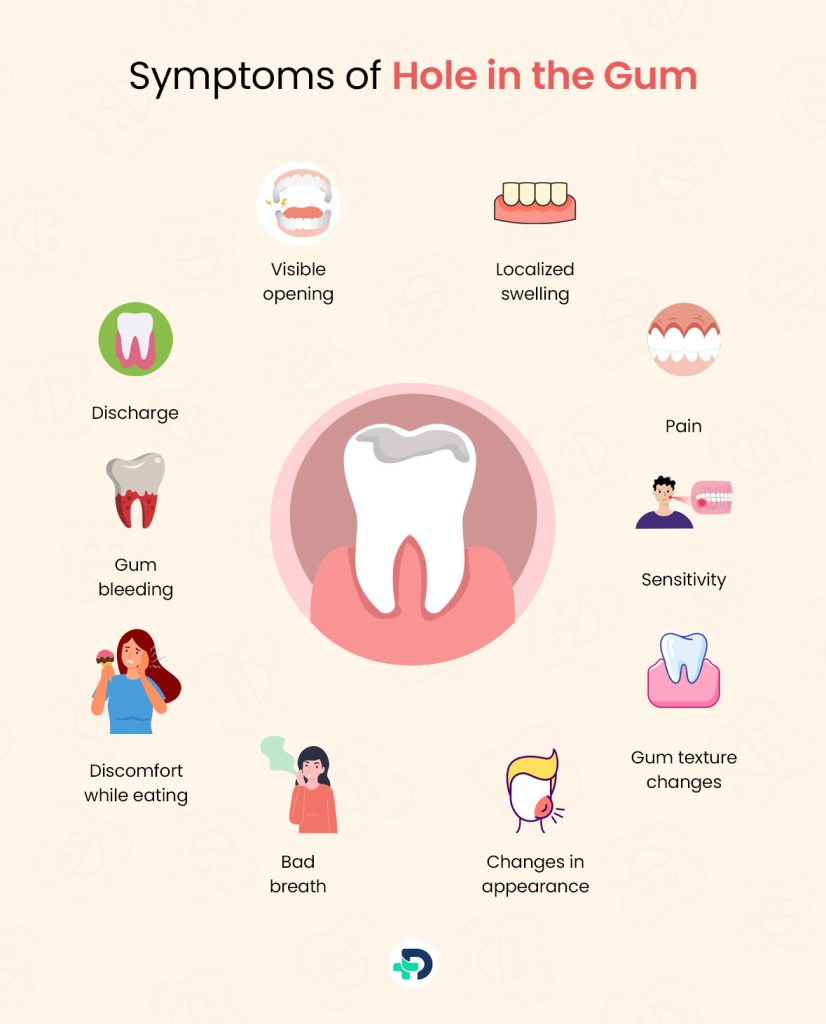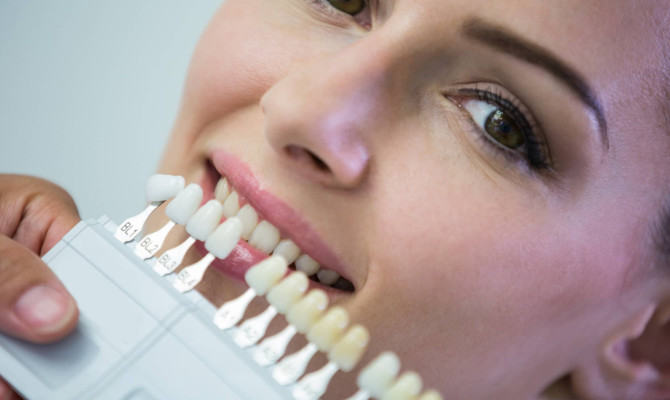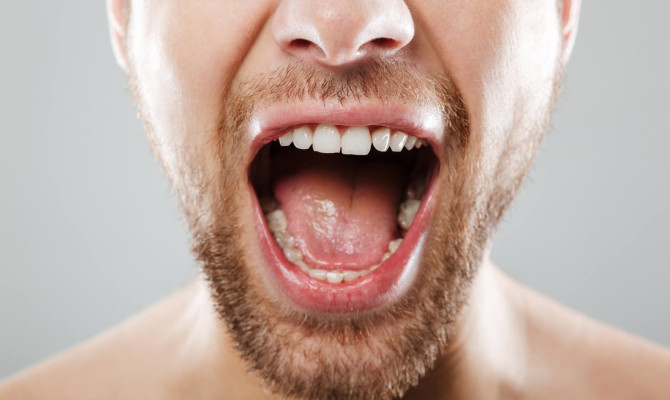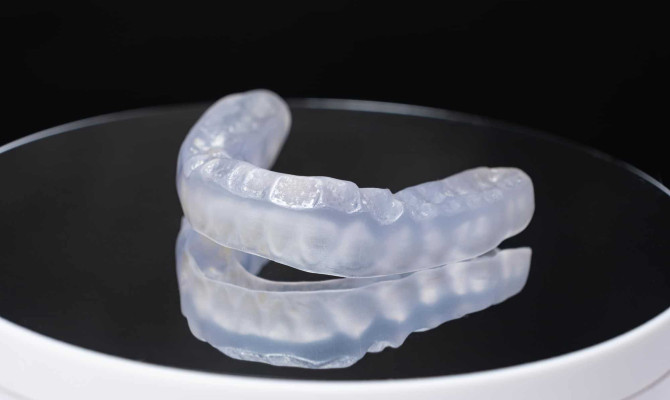Hole in the Gum: Causes & Management

- Gums
- 08 Sep 2023
Introduction
What is a Hole in the Gum?
An opening or void that appears in the gum tissue, a delicate, strong lining that encircles and supports the teeth—is called a “hole in the gums.” Many conditions, including gum disease, oral trauma, infections, etc., can cause this condition to appear. The causes, symptoms, diagnosis, and possible treatments of this ailment are examined in this article, which emphasizes the significance of obtaining competent dental care for an accurate assessment and management. 1 Introduction | Researched based study from National Library of Medicine

Symptoms


Symptoms of Hole in the Gum
- Visible opening in the gums
- Swelling
- Pus discharge
- Pain
- Bleeding
- Sensitivity
- Changes in texture
- Foul breath
- Changes in appearance
Recognizing specific science and demonstrating the existence of an opening or void within the tissue are necessary for identifying a hole in the gums. A few such indications could be:
Visible opening
- Detecting a tiny hole or tissue breach accompanied by a texture or color shift.
Localized swelling
- An abnormality may be indicated by the affected area seeming swollen, inflamed, or elevated.
Discharge
- If the hole is connected to an illness, pus or other fluids may be dripping from the area.
Pain
- A gum hole can cause wearing pain in various intensities, from moderate discomfort to excruciating pain.
Gum bleeding
- Particularly during brushing or flossing, may indicate a serious problem, including the existence of a whole.
Sensitivity
- The existence of a hole in the gums might cause increased sensitivity to hot, cold, sweet, or sour foods and beverages.
Discomfort while eating
- Any chewing or biting may become uncomfortable, especially near food.
Gum texture changes
- To the touch, the gums around the entire area may feel softer, swollen, or even sensitive.
- It may provide an environment where bacteria grow and cause halitosis or bad breath.
Changes in appearance
- It can change how the gums look, giving the impression that they are retreating or erratically inflamed. 1 Symptoms | Researched based study from National Library of Medicine , 2 Symptoms | Researched based study from National Library of Medicine , 3 Symptoms | Researched based study from National Library of Medicine ]
Anatomy
Recognizing the Gums structure
Our gums act as a shield for our teeth. They are composed of three layers:
- A deeper layer that attaches to the bone
- A middle layer that contains blood arteries
- A rigid outer layer
Also called gingiva, it plays a crucial part in maintaining our teeth. They consist of specialized tissues that support bone health maintenance.
Comprehending the structure of the gums is essential to valuing their function in dental health and identifying any potential alterations or deviations. If you have any concerns, you should speak with a dental professional for a comprehensive assessment and proper care.2 Anatomy | Researched based study from National Library of Medicine
Causes
What causes a Hole in the Gum?
- Gum disease
- Abscess
- Dental treatments
- Surgical procedures
- Trauma
- Oral infections
- Poor oral health
- Medical conditions
- Genetics
Here are some of the causes listed below in detail:
Gum disease
- Periodontal disease, often known as gum disease, is the most frequent cause. Gingivitis is when the gums become inflamed and may bleed during brushing. Usually minor, it can be resolved with better dental hygiene habits.
- If treatment is not received, it may worsen and lead to periodontitis, in which the tissues that support the teeth deteriorate and create pockets or holes between the gums and teeth.
- Over time, these pockets may expand into larger holes. The bone and connective tissues that support the teeth in place may begin to weaken over time as a result of them trapping debris and bacteria.
- The accumulation of plaque on teeth and gums is the leading cause of gum disease.
- It has bacteria in it that make toxins that cause inflammation and irritation.
- There could be several reasons, including bad dental hygiene, smoking, tobacco use, heredity, diabetes, certain medications, and hormonal fluctuations.
Gum abscess
- It is a localized pocket of pus that occurs within the tissue and is also referred to as a gum boil or periodontal abscess.
- It typically occurs as a reaction to an illness brought on by the bacterial invasion of the crevices between teeth and gums.
- It can hurt and must be treated immediately to avoid worsening.
- The primary cause is a bacterial infection, which usually enters the gum pockets through tiny tissue breaches or openings.
- They can increase plaque and induce an infection that irritates the area and forms access.
- Some symptoms include discomfort, redness, swelling, pus discharge, and foul breath.
- Although dental operations and surgeries are designed to enhance oral health, they may have unforeseen outcomes that include the creation of tiny holes in the tissue.
- Extracting a tooth from its socket includes making room for it to fall out and then taking it out. Although minimizing harm to neighboring tissues is the aim, there are situations in which the gum tissue is unintentionally affected.
Root canal treatment
- This includes cleaning the root canals and extracting the damaged or infected bulb. Occasionally, the devices used to clean and shape the canals may make a little hole in the gum tissue.
Surgical interventions
- Several dental procedures require incisions in the gum tissue to reach the structures under the surface.
- In some situations, the healing process causes tiny holes to grow in the gums after these treatments are completed.
- Though minor holes are typically anticipated during a heel extraction, any severe discomfort, swelling, or bleeding from the site should be reported to the dentist immediately.
- Problems like infection or sluggish healing sometimes result in bigger, more chronic holes.
Dental trauma
- This is used to describe any physical harm or hit to the lips that may come from mishaps, falls, collisions in sports, or other unexpected events like a variety of impacts on the gums and other oral structures.
- Teeth may come into solid contact with complex objects or one another when a direct blow or four is delivered to the mouth. The gums are sensitive tissues that may become damaged due to this stress.
- Furthermore, it may result in cuts or abrasions. Whereas lacerations are deeper cuts or scrapes on the tissue’s surface, abrasions are more superficial.
- The roots of severe dental trauma, particularly those involving powerful pressures, might result in face bone fractures. These may lead to holes or openings in the gum tissue where tooth or bone pieces have broken through.
- Regenerating new cells and sealing gaps is part of the gum tissue’s self-repairing process. However, tiny, transient holes may occur throughout the healing process, depending on its severity.
Infections of the mouth
- They can impact nearby tissues, such as the gums, and originate from various oral sources. Infections propagating from neighboring teeth may indicate cavities or infected dental roots, which may cause localized gum injury.
- The mouth’s vulnerable parts are typically where they begin. For example, a tooth with a cavity or deep groove can allow bacteria to proliferate.
- It can move across the mouth’s complex network of structures. If not contained, an infection can spread from the diseased tissue to the surrounding tissue.
- Pocket development may result from chronic inflammation and infection. These leave gaps where microorganisms can grow. The condition may eventually cause tissue deterioration and hole development.
Poor dental hygiene
- Keeping your mouth healthy requires practicing good dental hygiene. Insufficient oral hygiene habits may result in the buildup of plaque and tartar on teeth.
- Plaque is a sticky layer of bacteria that develops on teeth all day. It may create an atmosphere that is favorable to dangerous germs.
- They cause inflammation and the initial stages of gum disease by releasing toxins and irritating the gums.
- Practicing good dental hygiene is essential to prevent gum holes and other oral health problems.
Medical conditions
- Certain medical disorders might affect your gums and overall oral health. It may impact the immune system and blood circulation, raising the possibility of issues arising and may result in gum tissue gaps or holes.
- Diabetes that is not well managed can result in high blood sugar, impairing the body’s capacity to fend off infection and repair itself.
- Due to this immune response deficiency, gum disease may be more common and challenging to treat.
- It may also impact blood circulation, which could lessen blood supply to the tissues and make it harder for them to heal from injuries and fight infections. Additionally, it may postpone healing, which may impact recovery.
Genetics
- The way your body reacts to illnesses, including gum disease, is primarily determined by your genetics.
- Specific individuals may have inherited genetic traits that increase their susceptibility to it because of differences in their immune systems.
- Additionally, it may impact the integrity and structure of collagen fibers necessary to maintain healthy tissue.
- Variations in genes suitable for collagen can affect the tissue’s tensile strength and elasticity.
- A family’s medical history may indicate hereditary characteristics that raise the risk of experiencing related problems. 2 Causes | Researched based study from National Library of Medicine , 3 Causes | Researched based study from National Library of Medicine , 4 Causes | Researched based study from American Dental Association ]
Diagnosis
Diagnosis of Hole in the Gum
A dentist or other oral health specialist must assess to identify and diagnose gum holes.
Visiting the dentist
- A dentist appointment should be made if you believe you have holes in your gums or have any strange symptoms.
Physical inspection and evaluation
- During the consultation, the dentist will thoroughly examine your mouth, paying particular attention to any questionable regions.
- Your gums will be examined visually to look for any apparent holes, abnormalities, or alterations in the texture of the tissue.
- They could also employ dental equipment to probe the gum pockets and gauge their depth gently.
Imaging Techniques
This could be applied in some circumstances to offer a more thorough assessment. Typical techniques consist of the following:
X-rays
- Dental X-rays highlight the bone, essential information to know how much damage has been done.
Dental scans
- Cone beam computer tomography (CBCT), one of the more sophisticated imaging techniques, produces three-dimensional images with fine-grained information.
Clinical assessment
- The dentist will evaluate the general condition of your mouth and any possible problems based on the imaging tests and physical examination findings.
- They will consider elements, including the depth of the pockets and any indications of inflammation or infection.
Identifying the root causes
- The dentist will endeavor to determine the root causes.
- This can entail evaluating additional contributory causes or problems like infections from prior dental work. 5 Diagnosis | Researched based study from National Library of Medicine
Treatment
Treatment for Hole in the Gum
It entails treating the underlying cause and encouraging the injured tissue to heal.
Non-invasive methods
Medication with antibiotics
- To control and eradicate the infection, your dentist may recommend antibiotics if that is the cause.
- The assistance promotes healing and stops the infection from spreading.
Dental hygiene
- It would help if you enhanced your dental hygiene routine to avoid these problems.
- Using an antimicrobial mouthwash in addition to regular brushing and crossing techniques can help preserve gum health and avert further problems.
Surgical Procedures
Incision and Drainage
- When a gum abscess is the root of the problem, an incision may be made to remove any collected pus and drain the abscess.
- The region is typically thoroughly cleaned after this surgery, which helps to reduce pressure and pain.
Gum grafting
- Gum grafting may be considered due to tissue loss brought on by gingivitis, injury, or other circumstances.
- This treatment involves transplanting healthy gum tissue to the afflicted part of your mouth from another place to encourage tissue regeneration.
Restorative treatments
Fillings
- If the cavity results from dental decay that has penetrated the gum line, the tooth structure could be restored by applying a dental filling.
- This aids in sealing the tissue hole as well.
Crown
- This indicates whether it is connected to a tooth with dental trauma or severe damage.
The best treatment will be based on the cause, severity, and general health. This plan might incorporate these strategies based on your specific requirements.
Follow up
- It’s crucial to adhere to your dentist’s post-treatment care and maintenance instructions after receiving treatment.
- This can entail scheduling frequent follow-up visits to track your healing development. 6 Treatment | Researched based study from American Academy of Periodontology
Prevention
Prevention of Gum Hole
Routine dental examinations
- Make time for routine dental examinations with your dentist.
- During these visits, your dentist can keep an eye on the condition of your gums, look for any early warning indicators of gum disease, and quickly treat any issues.
- Manage underlying medical conditions like diabetes.
Adequate dental hygiene practices
- Rinse your teeth with chloride toothpaste at least twice a day. Use a toothbrush with bristles and carefully brush the gum line.
To get rid of food particles, floss every day.
- Use a mouthwash with antimicrobial properties to help keep microorganisms and your mouth down.
Changes in lifestyle
- Consume a vitamin- and mineral-rich, well-balanced diet. A diet heavy in sugar and processed carbs may aggravate gum disease.
- Whole grains, lean meats, and fruits and vegetables should all be included in the diet.
- Gum disease and slowed healing are associated with tobacco use and smoking. Giving up tobacco use can significantly enhance your dental health.
- Too much alcohol use might have an impact on dental health. If alcohol is something you decide to do, do so in moderation.
- Water consumption supports saliva production, which helps to remove bacteria and food particles that cause gum disease. 7 Prevention | Researched based study from National Institute of Dental and Craniofacial Research ,8 Prevention | Researched based study from National Library of Medicine ]
FAQs
FAQs on Gum Holes
Is a hole in gum serious?
- It could be due to various reasons. It is important to consult a dentist to determine the cause and receive appropriate treatment.
- Ignoring it might lead to more serious issues, so seeking professional advice is recommended.
How long does hole in gum last?
- It depends on its cause and how its treated. Small holes from minor issues might heal on their own within a few days to a couple of weeks.
- However, if it is due to a more serious condition like access or gum disease it may not heel without proper treatment.
Can hole in gum grow back?
- Gum tissue does not exactly grow back in the same way that other tissues do. The healing process depends on the cause.
How to fix a hole in my gum at home?
- Maintaining good oral hygiene. Rinsing your mouth with warm salt water to help keep the area clean.
- Over the counter pain reliever and avoiding tobacco and alcohol can help.
The Bottom Line
Bottom Line for Gum Holes
The outlook or prognosis for a hole in the gums depends on the underlying cause and how its treated. For minor holes’ proper oral hygiene and care can often help it to heal overtime. However, if it is due to more serious issues the prognosis can vary. Timely and appropriate treatment by a dentist is crucial in these cases. If gum disease is not treated, it can worsen and cause more tissue damage as well as possibly even tooth loss. It is always advised to consult a dentist to identify the problem and select the best course of action. Early intervention can reduce difficulties and increase the likelihood of a successful outcome.
Any feedback on this article?
 This Articles content was accurate
This Articles content was accurate Very Informative Article
Very Informative Article I have a question or a comment
I have a question or a comment
 This article contains inaccurate content
This article contains inaccurate content This article was not helpful
This article was not helpful I have a question or a comment
I have a question or a comment
We appreciate your helpful feedback!
Checkout our social pages
References
-
National Library of Medicine
Introduction | Symptoms
-
National Library of Medicine
Symptoms | Anatomy | Causes
-
National Library of Medicine
Symptoms | Causes
-
American Dental Association
Causes
-
National Library of Medicine
Diagnosis
-
American Academy of Periodontology
Treatment
-
National Institute of Dental and Craniofacial Research
Prevention
-
National Library of Medicine
Prevention



































